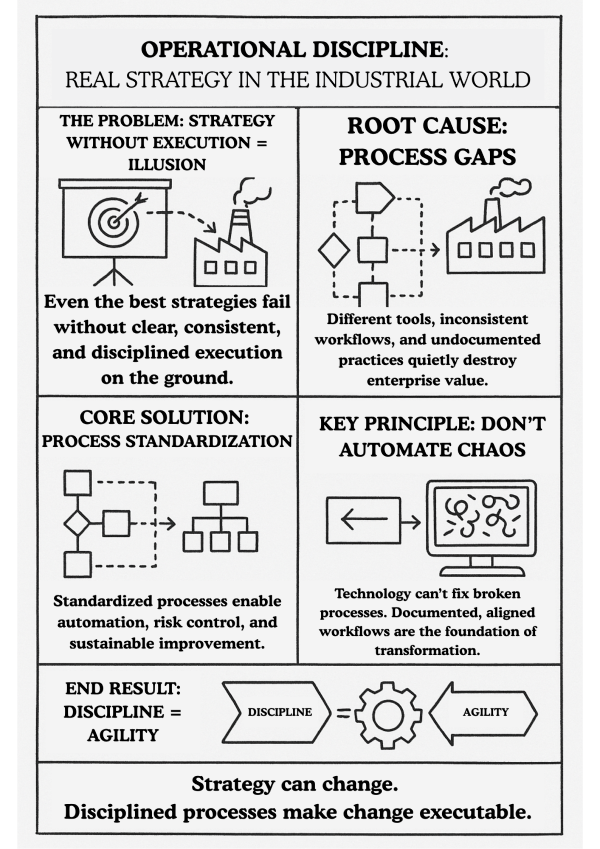Strategy Isn’t What You Say—It’s What You Execute
In capital-intensive industries, strategy isn’t just a PowerPoint—it’s a process. Even the best strategies fail when frontline execution lacks clarity, consistency, and discipline. Operational chaos—whether in asset maintenance, cost control, or procurement—slowly erodes competitive advantage, regardless of strategic intent. In today’s industrial landscape, operational discipline isn’t just an enabler of strategy—it is strategy.
Why Process Gaps Quietly Erode Enterprise Value
From budget overruns to unplanned downtime, much of the value loss in mining and energy operations stems from broken or undocumented processes. One plant uses spreadsheets, another uses standalone tools, and a third relies on tribal knowledge. The result is process fragmentation that no amount of technology can fix. Leaders must ask: Are we really executing one strategy, or just co-existing under one balance sheet?
Process Standardization as a Competitive Weapon
What separates high-performing organizations is not just capital—but consistency. Companies that standardize how they manage assets, track costs, approve purchases, and report risk create enterprise-wide clarity. This enables automation, risk management, and data analysis. In a volatile market, repeatable excellence matters more than localized genius. Standard processes scale—heroics don’t.
Technology Can’t Compensate for Process Confusion
Too many firms automate poor processes and then wonder why performance doesn’t improve. ERP systems or digital twin platforms layered on inconsistent workflows only digitize the confusion. Before implementing transformation tech, leaders must interrogate the process: Is it current? Is it documented? Is it aligned across functions and sites? Technology should amplify good design—not mask bad habits.
Cross-Functional Collaboration Begins With Process Clarity
Process breakdowns often masquerade as people problems. Finance says operations are undisciplined. Maintenance says procurement is slow. In reality, the problem is almost always inconsistent handoffs, undefined thresholds, or missing feedback loops. Clear, documented, and shared processes transform blame into alignment—and cross-functional clarity into shared outcomes.

Discipline Today Builds Agility Tomorrow
It may sound paradoxical, but standardization enables flexibility. When your processes are documented and digitized, you can adapt faster to disruption. Whether it's a new regulatory requirement, market swing, or supply chain issue, process-driven organizations reconfigure faster because they know what to change—and what to protect. Strategic agility begins with operational rigor.
Operational Discipline Is the Strategy You Can Control
Commodity markets are volatile. Geology is unpredictable. Labor conditions shift. But your internal processes—how you plan, measure, and execute—are fully in your control. In an era where resilience is the new efficiency, operational discipline is your most enduring competitive edge.
